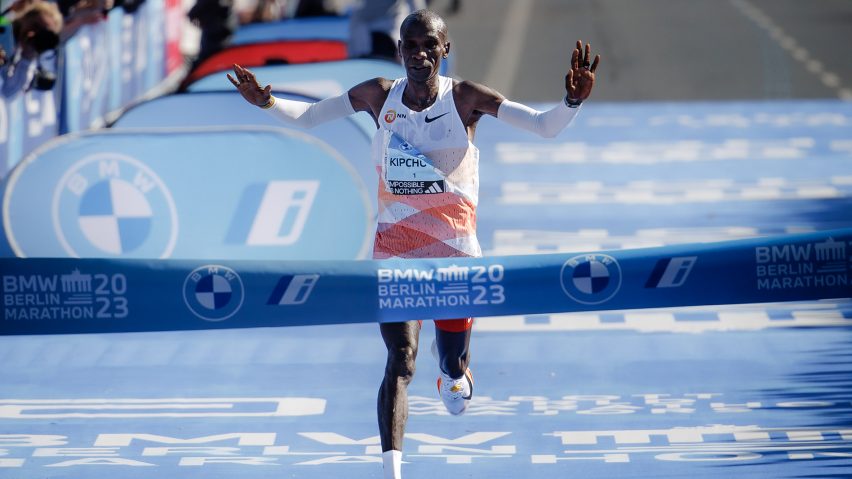
The race to create the ultimate running super shoe
For years, sportswear brands Adidas and Nike have been competing to design record-beating running trainers. As Nike officially launches the Alphafly 3, Dezeen plots a brief timeline of the so-called battle of the super shoes.
Marathon records have tumbled in the last 20 years, with most experts agreeing that advancements in running-shoe technology have played a significant role.
Spurred on by the proximity of the first officially recognised sub-two-hour marathon, Adidas and Nike have invested heavily in developing the trainer that they hope will see their sponsored athletes break the elusive barrier in open competition.
The phenomenon gained particular attention recently after landmark records were broken in quick succession – first by a runner wearing Adidas and then by a Nike athlete just a fortnight later.
At times it has proved controversial, with claims that the focus on footwear amounts to "technological doping", but the trend shows little sign of slowing down.
Here are eight major moments in the super-shoe wars:
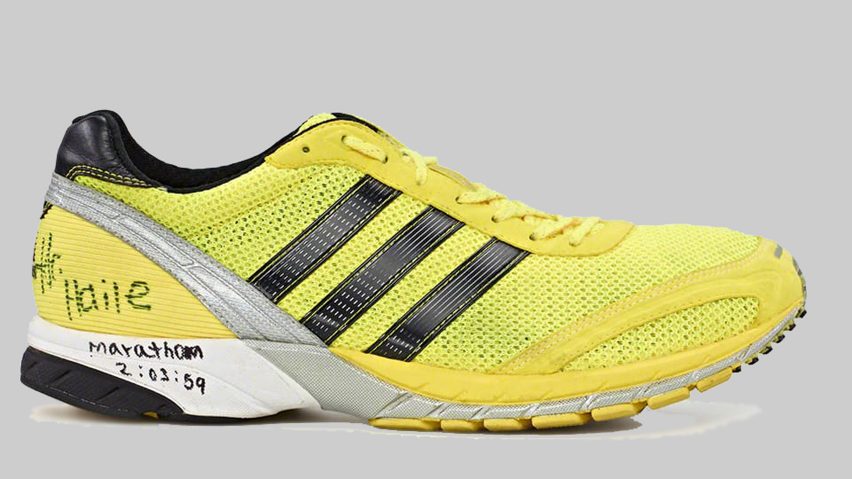
Adidas Adizero Adios, 2008
Exactly when the super-shoe era began depends on who you ask. Adidas would argue it dates back to around 2004, when the brand tasked Japanese shoe designer Toshiaki Omori with creating the perfect running trainer. Eschewing the contemporary preference for digital design, Omori prioritised using moulds of real feet to produce a shoe with the closest possible fit.
The result was the Adidas Adizero series. According to Adidas, Ethiopian long-distance runner Haile Gebrselassie decided to wear the first prototype in the collection – the Adidas Adizero Adios – after trying them on in his hotel room the night before the Berlin Marathon in September 2008.
He would go on to break his own world record the next day by a significant margin of 29 seconds, becoming the first person to run a marathon in under two hours and four minutes. The two-hour barrier was suddenly much closer.
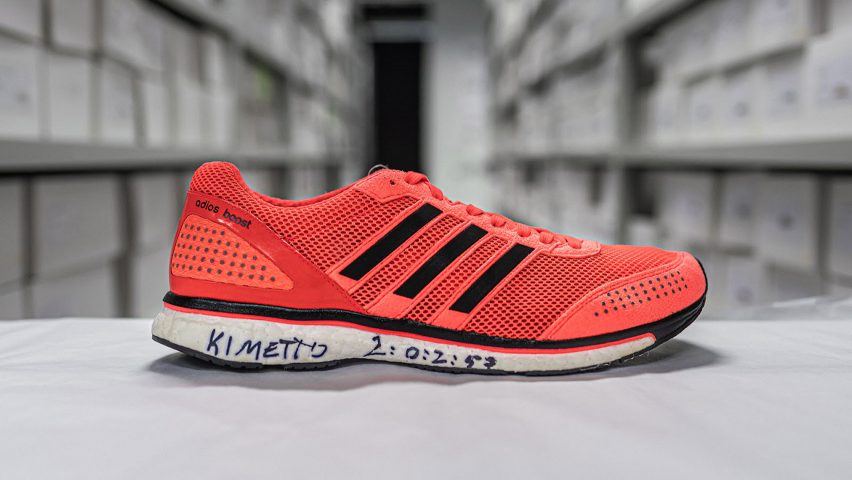
Adidas Adizero Boost 2, 2014
Adidas's Adizero line came to dominate the marathon-running world for several years.
Kenyan Patrick Makau broke Gebrselassie's record in 2011 wearing the new-and-improved Adidas Adizero Adios 2, and two years later, his countryman Wilson Kipsang broke the record again with the help of the Adidas Adizero Boost. This shoe featured a newly developed cushioning system using thermoplastic polyurethane foam – a significant departure from the ethylene-vinyl acetate that had previously been favoured in running-shoe design.
Then, at the 2014 Berlin Marathon, Dennis Kimetto broke the record once again, this time in the Adidas Adizero Boost 2, which combined the traction and cushioning technology of the Boost with the more breathable mesh upper of the Adios 2. Kimetto became the first person to run the distance in under two hours and three minutes. The same shoes were on the feet of the second-placed men's finisher and the top two finishers in the women's race.
The next year, Adidas began developing the first shoe explicitly designed to shatter the two-hour marathon barrier – the Adidas Adizero Sub2. Released in 2017, it focused on incorporating the springy support of the Boost technology into a much lighter overall product.
However, the Adidas Adizero Sub2 was not able to achieve its goal. Instead, it was overshadowed by a rival release from Nike that would lead to a revolution in elite running-shoe design.
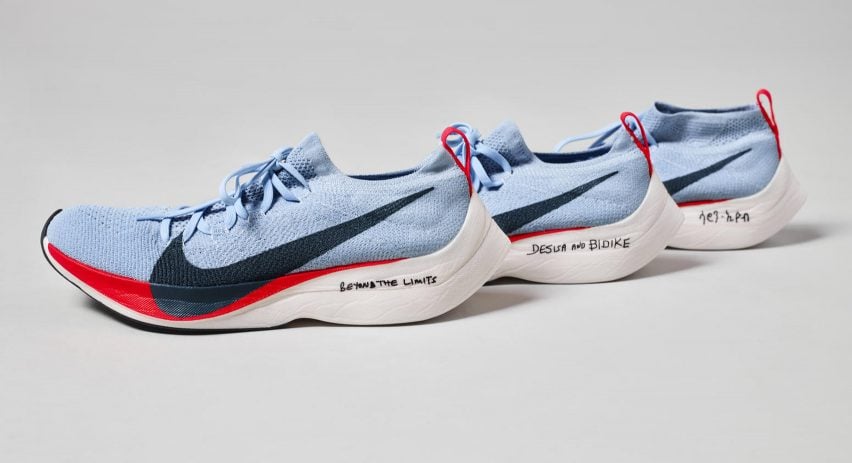
Nike ZoomX Vaporfly Elite, 2017
Nike had been quietly working on a project of its own since 2014. Its research had led to two innovations: the extremely lightweight ZoomX foam, which allowed for an extra-thick sole, and the insertion of a curved carbon-fibre plate within the midsole that acted like a springboard.
Nike chose to distribute prototypes of the resulting shoes among its elite athletes in 2016 before the model had been released, and all three podium finishers in the men's marathon at the Olympics that year were wearing the prototypes.
It was not until March 2017 that Nike officially unveiled the Vaporfly Elite – declaring that it had been developed to breach the two-hour marathon mark at the specially organised Breaking2 race in the coming May. Olympic gold medallist Eliud Kipchoge finished the race in two hours and 25 seconds – narrowly missing the sub-two-hour dream but setting an unofficial world record.
The brand released a consumer version later in the year, named the Vaporfly 4% after research findings that the shoe improved running efficiency by four per cent compared to alternatives on the market. The chunky-soled Vaporflys were a significant design departure from the classic flat marathon trainer, and for many their emergence marks the start of the super-shoe era.
In September 2018, Kipchoge officially beat Kimetto's 2014 marathon time by a margin of 78 seconds wearing a prototype of the Vaporfly Elite's successor, the Vaporfly Next%, with a lighter "Vaporweave" upper. In 2019, Brigid Kosgei broke the long-standing women's marathon world record by 81 seconds wearing the Vaporfly Next%.
By now, the Nike Vaporfly and its transformational impact on running as a sport was becoming controversial, with some arguing that the shoes conferred an unfair advantage on the wearer. Analysis of 500,000 marathon and half-marathon times by The New York Times found that people wearing Vaporflys ran between three and four per cent faster than those of similar abilities in other shoes. Sports scientist Ross Tucker declared that the shoes "broke running".
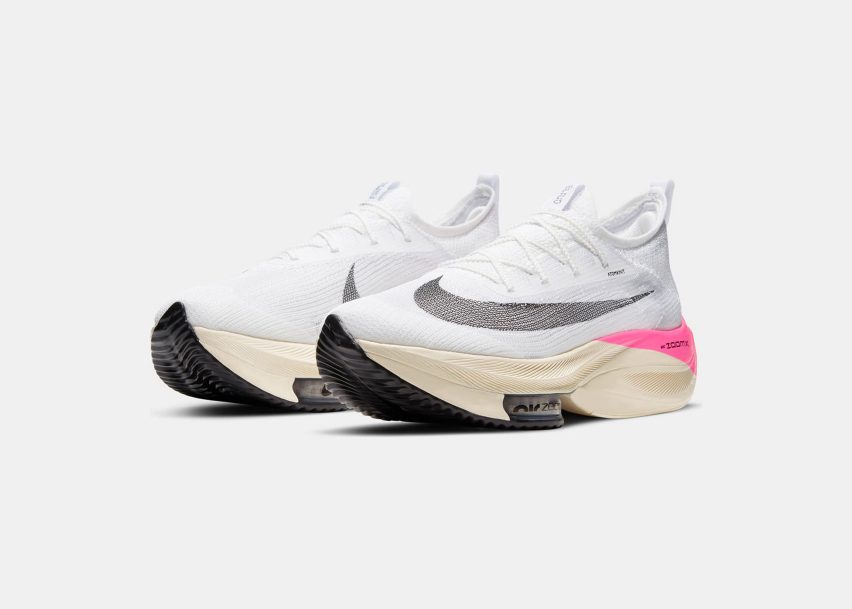
Nike Air Zoom Alphafly Next%, 2019
While the athletics world scrambled to adjust to the impact of the Vaporfly, Nike was already developing something even more advanced.
A day before Kosgei clocked her world record in October 2019, Kipchoge attempted to break the two-hour mark once again. This time he was successful, crossing the finish line in one hour, 59 minutes and 40 seconds – though as with his 2017 effort, the record remained unofficial because his run involved the use of rotating pacemakers. On Kipchoge's feet were a prototype of the Nike Air Zoom Alphafly Next%.
The shoes featured the addition of Nike Air Zoom pods under the ball of the foot, intended to provide additional cushioning and energy return, as well as even more ZoomX foam. Rumours that Kipchoge's prototypes had included not one but three carbon-fibre plates were widely reported, but later denied by Nike.
In January 2020, governing body World Athletics took action over concerns about the impact of Nike's super shoes on the sporting integrity of long-distance running. It published new regulations requiring athletes to only race in shoes that had been available to purchase for at least four months – effectively forbidding the use of prototypes. Sole thickness was also limited to 40 millimetres and shoes with more than a single rigid plate were banned.
In February 2020, Nike launched the Alphafly Next% officially, confirming that it complied with the new rules.
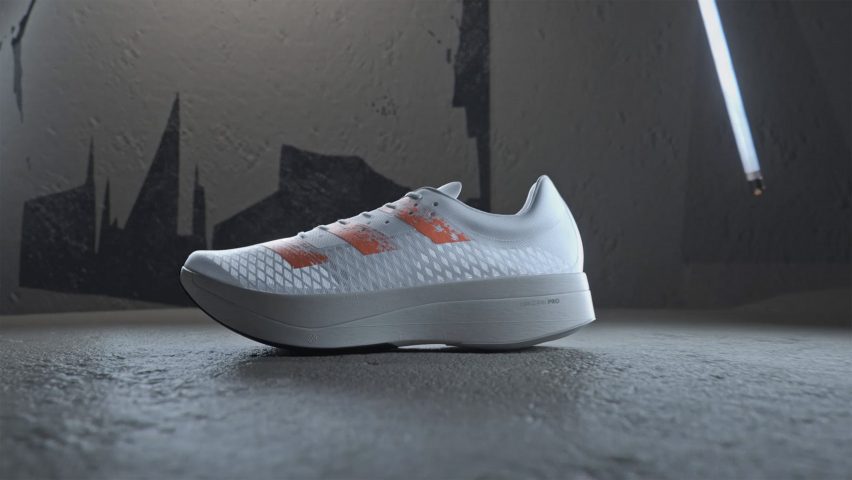
Adidas Adizero Adios Pro 1, 2020
Following the success of the Vaporfly, Adidas joined Nike in dropping the low-profile conventional marathon shoe in favour of a thicker foam sole.
However, unlike most other competing brands Adidas did not adopt full-length carbon plates. Instead, it developed "energy rods" – five carbon-infused rods placed and curved to mirror the bones of the foot. The brand claimed this system allowed for a "more natural gait" than a large carbon plate.
The Adizero Adios Pro 1 was launched in May 2020 and in September of that year, Kenyan runner Peres Jepchirchir wore them as she broke the women's half-marathon world record in Prague with a time of one hour, five minutes and 34 seconds – a 37-second improvement on the previous record.
After the race, Jepchirchir was pictured holding up her shoe in triumph. "I was exhausted for the last five kilometres," she said, "But the new shoes have helped me set a record." She went on to knock another 18 seconds off her own record a month later.
In another significant turn of events, World Athletics introduced a loophole to its rules restricting the use of prototypes following industry lobbying. The December 2020 amendment allowed "development shoes" to be worn in races once their specifications are approved by the regulator.
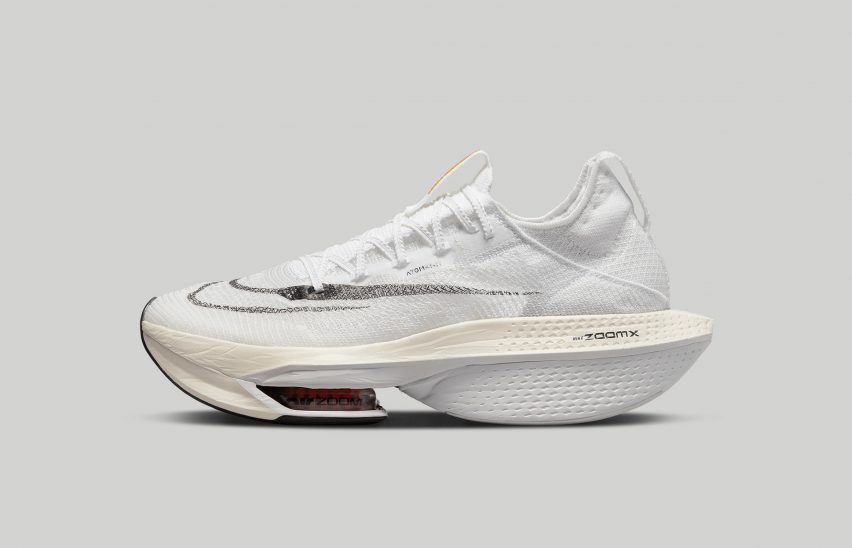
Nike Air Zoom Alphafly Next% 2, 2022
Nike continued to innovate, and in June 2022 it launched the second iteration of the Alphafly.
This retained many of the features of its predecessor, but with additional foam under the air pods to assist with the transition of the runner's stride from heel to forefoot. The heel was also widened to improve stability, while the Atomknit upper was tweaked to improve breathability, comfort and snugness.
At the Berlin Marathon in September 2022, the Alphafly Next% 2 helped Kipchoge beat the world record he had set four years earlier wearing the Vaporfly Next% by 30 seconds, this time crossing the finish line in two hours, one minute and nine seconds.
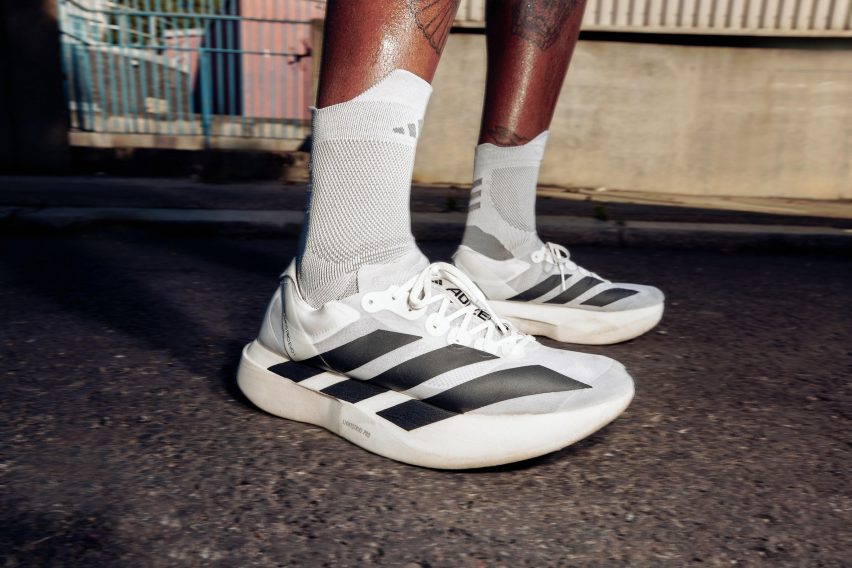
Adidas Adizero Adios Evo Pro 1, 2023
The battle of the super-shoes was ratcheted up a notch in September this year when Tigst Assefa shattered Kosgei's 2019 women's marathon world record by more than two minutes at the Berlin Marathon.
Assefa wore the newly launched Adidas Adizero Adios Evo Pro 1. Before the race, Assefa had described running in the shoe as "an incredible experience". Afterwards, she was pictured kissing it on the finish line.
The Adizero Adios Evo Pro 1 was designed to pack super-shoe technology into a lighter trainer. Weighing just 138 grams, it is 40 per cent lighter than any other racing super-shoe Adidas has ever created.
Part of the weight savings was achieved through new, lighter versions of Adidas's Lightstrike Pro foam, the outsole and the mesh upper, as well as the removal of the sock-liner. The brand also pointed to a "first-of-its-kind forefoot rocker" placed at 60 per cent the length of the shoe, which it said improves running economy and facilitates forward momentum.
The shoe was named by Time magazine as one of the 200 best inventions of 2023, but also attracted criticism over the fact that despite costing £400 ($500), it is only designed to be worn once.
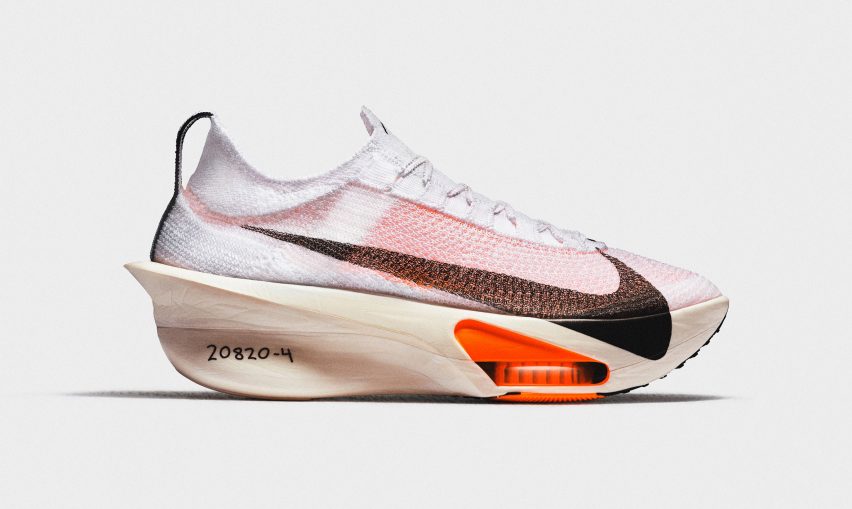
Nike Alphafly 3, 2023
Just two weeks after Assefa set her record, super shoes hit the headlines again when Kipchoge's 2022 world record was bested by his fellow Kenyan, Kelvin Kiptum, who completed the Chicago Marathon in two hours and 35 seconds – tantalisingly close to the two-hour threshold.
Kiptum was wearing the Nike Dev 163, a prototype version of the Nike Alphafly 3 officially launched this week and on sale in January 2024. Second-placed runner Benson Kipruto, wearing the Adidas, finished over three minutes behind Kiptum, while women's race-winner Sifan Hasan was also in Nike Dev 163s.
Nike describes the Alphafly 3 as the lightest in the series and its most extensively tested racing shoe ever, with more than 32,000 kilometres covered by runners in development. It stuck with the Air Zoom pods, ZoomX foam and carbon-fibre plate formula of the previous iterations but aimed to improve the shoe's stability, comfort and propulsion.
The most obvious visible change from its predecessor, the Alphafly Next% 2, is the shoe's continuous bottom, which Nike said aids a smoother heel-to-toe transition. Foam was also removed from the midsole towards the back of the shoe to save grams and concentrate the runner's weight on the Air Zoom units. In addition, the carbon plate was widened to improve running stability, while other tweaks were made to assist arch support and reduce rubbing.
In an apparent reference to the single-use Adidas Adizero Adios Evo Pro 1, Nike has also emphasised the Alphafly 3's durability, claiming that it was tested over a minimum distance of 200 miles (322 kilometres).
For now, the coveted official sub-two-hour marathon remains slightly beyond reach. Both Nike and Adidas will keep competing to ensure that the first foot to cross the finish line inside that time will be bearing their logo.
Main image, showing Eliud Kipchoge winning the 2023 Berlin Marathon wearing the Nike Alphafly 3, is by Nike.